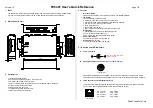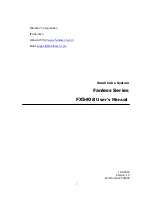
Quick Start Guide
13
June 2016
8.0 Mount the Transmitter
8.1 Transmitter mounting, direct mount head with valves
It is not necessary to retract the Rosemount Annubar when direct mounting a
transmitter with valves.
1. Place PTFE O-rings into grooves on the Rosemount Annubar head.
2. Align the high side of the transmitter to the high side of the sensor (“Hi” is
stamped on the side of the head) and install.
3. Tighten the nuts in a cross pattern to 384 in-lb (43 N-m).
8.2 Transmitter mounting with remote mount head
Temperatures in excess of 250 °F (121 °C) at the sensor module diaphragms will
damage the transmitter. Remote mounted transmitters are connected to the
sensor by means of impulse piping, which allows process temperatures to
decrease to a point where the transmitter is no longer vulnerable.
Different impulse piping arrangements are used depending on the process fluid
and must be rated for continuous operation at the pipeline design pressure and
temperature. A minimum of
1
/
2
-in. (12 mm) outer diameter stainless steel tubing
with a wall thickness of at least 0.035-in. (1 mm) is recommended. Threaded pipe
fittings are not recommended because they create voids where air can become
entrapped and create leakage points.
The following restrictions and recommendations apply to impulse piping
location:
1. Impulse piping that runs horizontally must slope at least one inch per foot
(83 mm/m).
- Slope downward (toward the transmitter) for liquid and steam applications.
- Slope upward (toward the transmitter) for gas applications.
2. Outdoor installations for liquid, saturated gas, or steam may require insulation
and heat tracing to prevent freezing.
3. An instrument manifold is recommended for all installations. Manifolds allow
an operator to equalize the pressures prior to zeroing and isolates the process
fluid from the transmitter.
00825-0400-4809 Rev FB.fm Page 13 Thursday, June 16, 2016 1:16 PM










































